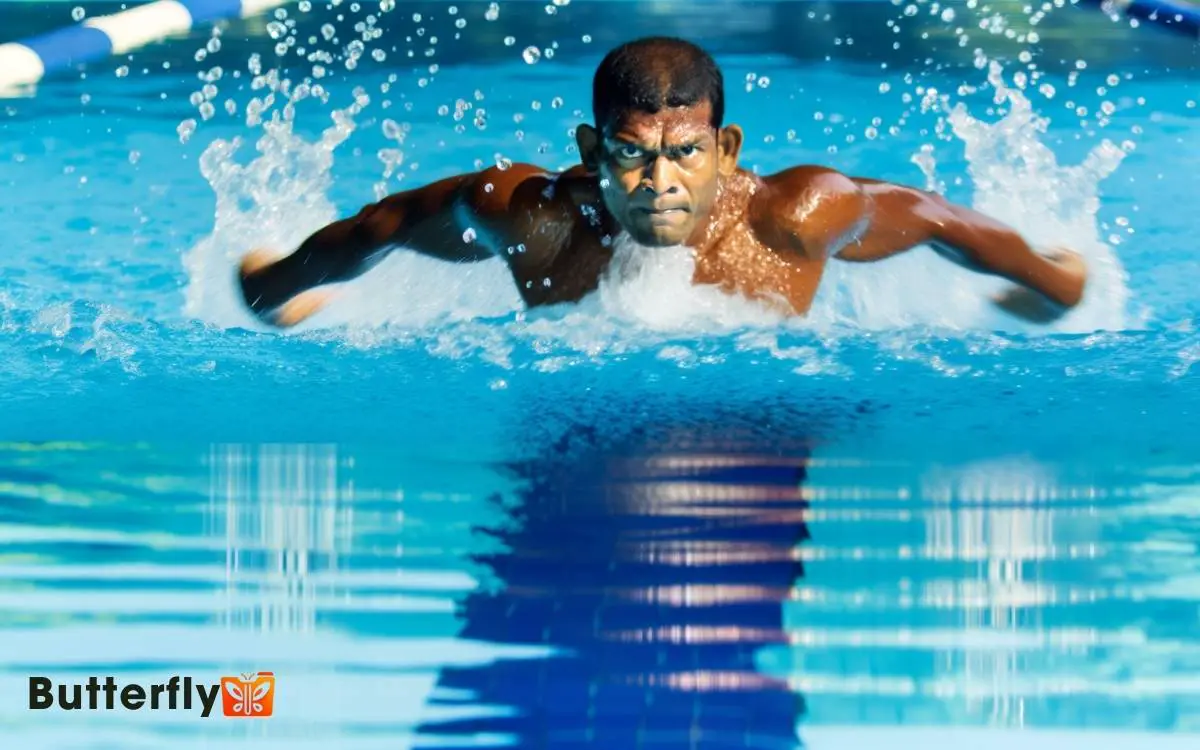How To Swim Butterfly Faster? Effective Techniques!
To swim butterfly faster, streamline your body by aligning your head, hips, and feet, and engage your core. Inhale as your arms exit and keep your head low.
Enter the water outside your shoulders with elbows high, utilizing a keyhole pattern. Kick from the hips with a fluid motion, emphasizing rhythm with your arms.
Sync your arm and leg movements, timing your breaths right. Practice powerful turns and use interval training to build endurance.
Focus on minimizing drag and maximizing propulsion. Keep pushing yourself, focusing on these techniques step-by-step, and you’ll discover even more effective ways to improve.

Key Takeaways
Streamline Your Body Position
To swim the butterfly stroke faster, you must streamline your body position by keeping your head, hips, and feet aligned to reduce drag.
Engage your core to maintain a flat, horizontal position. As you initiate the stroke, push your chest slightly down to generate forward momentum.
Keep your head neutral, looking straight down to avoid lifting it too high, which increases resistance. Your hips should remain close to the surface, minimizing the up-and-down motion.
Focus on kicking from your hips rather than your knees, ensuring your feet stay pointed. This technique will create a smoother, more efficient glide through the water.
Improve Your Breathing Technique
Mastering your body position sets the stage for optimizing your breathing technique during the butterfly stroke.
To breathe effectively:
- Timing is Everything: Inhale as your arms exit the water and your body lifts. Exhale when your face returns to the water.
- Minimal Disruption: Keep your head low during the breath to maintain streamlined movement.
- Consistent Rhythm: Breathe every two strokes to balance oxygen intake and maintain momentum.
- Core Engagement: Use your core muscles to lift your body for breathing without breaking form.
Enhance Arm Movement Efficiency
Maximize your butterfly stroke by focusing on the catch phase, where your hands enter the water just outside your shoulders and immediately angle downward.
This sets you up for a powerful pull. Keep your elbows high and sweep your hands in a keyhole pattern, accelerating as they move past your hips.
To visualize:
| Phase | Key Action |
|---|---|
| Catch | Hands enter, angle down |
| Pull | High elbows, keyhole pattern |
| Recovery | Hands exit, relaxed above water |
Stay streamlined, minimizing drag. Practice these movements with intention and precision. Engage your lats and core, driving force from your upper body.
By refining your arm movement efficiency, you’ll cut through the water with speed and agility, transforming your butterfly stroke into an innovative powerhouse.
Strengthen Your Kick
Building a powerful butterfly kick starts with engaging your core and hips to drive your legs in a fluid, dolphin-like motion. Focus on creating a seamless rhythm between your upper and lower body. To maximize efficiency, keep your legs close together and generate propulsion from your hips rather than your knees. Practicing drills like body dolphin undulations and fin work can help refine your technique. Just like mastering a strong kick, understanding how to make a money butterfly in investments or business requires rhythm, control, and consistent effort.
To strengthen your kick, incorporate these drills into your training:
- Vertical Kicking: Tread water using only your butterfly kick. This builds endurance and power.
- Kickboard Drills: Hold a kickboard and practice your kick with your face in the water. This isolates your legs and engages your core.
- Fins Training: Use fins to enhance the resistance and amplify the effectiveness of your kick.
- Dryland Exercises: Incorporate exercises like flutter kicks and leg raises to strengthen your hip flexors and core.
Perfect Your Timing
To perfect your timing in the butterfly stroke, synchronize your arm movements with your kick, ensuring each pull propels you forward efficiently.
Focus on optimizing your breathing rhythm by timing your breaths at the peak of your arm recovery to maintain a streamlined position.
With practice, you’ll achieve smoother, more powerful strokes and improved overall speed.
Synchronize Arm and Kick
Achieving perfect synchronization between your arm strokes and dolphin kicks is essential for enhancing your butterfly swimming efficiency and speed.
Focus on the following steps to nail this complex coordination:
- Initiate the Stroke: Start your arm pull by pressing down in the water as your head and chest rise. Your first kick should coincide with this movement.
- Catch Phase: As your hands move outward and downward, execute a strong second kick. This kick propels your body forward.
- Recovery Phase: While your hands exit the water, keep your body streamlined and prepare for the next stroke.
- Timing Practice: Consistently practice this timing in drills, using fins or other aids if necessary, to reinforce muscle memory.
Mastering this synchronization will make your butterfly stroke more fluid and powerful.
Optimize Breathing Rhythm
Mastering your breathing rhythm in butterfly swimming is essential for maintaining your timing, conserving energy, and sustaining speed throughout the race.
To optimize this, inhale quickly during the arm recovery phase when your head naturally rises. Exhale steadily as your face returns to the water. This helps you maintain a streamlined position and reduces drag.
Practice breathing every two strokes to find a rhythm that suits your pace and endurance. Don’t lift your head too high; a small nod is enough. Keep your chin close to the water to minimize resistance.
Perfecting this technique will let you conserve energy, allowing for a powerful, sustained performance. Stay focused, practice diligently, and you’ll see significant improvement in your butterfly speed.
Increase Core Strength
Consistently focusing on core strength will greatly enhance your butterfly stroke efficiency and speed. A powerful core stabilizes your body, allowing for smoother, more controlled movements.
To innovate your training, incorporate these four essential exercises:
- Planks: Hold a plank position for 1-2 minutes to engage your entire core.
- Russian Twists: Perform 3 sets of 20 twists with a medicine ball to strengthen obliques.
- Leg Raises: Complete 3 sets of 15 leg raises to target lower abs.
- Supermans: Execute 3 sets of 20 reps to enhance your lower back and glutes.
Optimize Your Start
To optimize your start in butterfly, focus on perfecting your launch technique and maintaining a streamlined body position.
Propel yourself off the block with explosive power and immediately tuck into a tight, hydrodynamic form.
Perfect Your Dive Technique
Achieving a powerful and streamlined dive is essential for a fast butterfly start, setting the tone for the entire race.
To perfect your dive technique, focus on these key elements:
- Stance: Position your feet shoulder-width apart, with the dominant foot slightly forward. Grip the front of the starting block firmly.
- Launch: Explosively push off using both legs, engaging your core for maximum propulsion. Aim to achieve a 45-degree angle.
- Flight: Streamline your body by keeping your head between your arms, hands together, and toes pointed. Your body should form a tight, arrow-like shape.
- Entry: Enter the water fingertips first, maintaining your streamlined position to minimize resistance.
Master these steps, and you’ll set yourself up for a faster, more efficient race.
Streamline Body Position
After perfecting your launch, it’s essential to maintain a streamlined body position to optimize your start and reduce drag. Keep your head aligned with your spine, eyes focused downward.
Engage your core to stabilize your torso. Extend your arms fully in front of you, hands overlapping, creating a narrow profile to slice through the water efficiently.
Point your toes and keep your legs straight, minimizing resistance. Avoid unnecessary movements; every splash wastes energy. Visualize yourself as a torpedo—sleek and powerful.
Focus on Turns
Mastering the butterfly turn requires a blend of precise timing, streamlined body position, and explosive power off the wall. You need to refine each element to gain a competitive edge.
Here’s how to perfect your turns:
- Approach the Wall: Maintain speed and start your turn with a strong two-handed touch. Guarantee your last stroke propels you forward.
- Tuck and Spin: Quickly tuck your knees to your chest and initiate a tight, swift spin. Keep your body compact for minimal drag.
- Push Off: Plant your feet firmly and push off the wall with maximal force. Aim for a streamlined position immediately.
- Streamline and Kick: Glide in a tight streamline, then engage in powerful dolphin kicks to regain momentum.
Implement these steps to revolutionize your butterfly turns!
Build Endurance
Building endurance in butterfly swimming requires a strategic combination of interval training, consistent practice, and proper recovery techniques. Start by incorporating high-intensity interval training (HIIT) into your routine.
Alternate between short bursts of maximum effort and periods of active rest. Aim for 50-meter sprints followed by 25 meters of slow, controlled strokes. Repeat this cycle, gradually increasing the number of repetitions.
Commit to regular swim sessions, at least four times a week. Consistency is key to building muscle memory and stamina.
After intense workouts, prioritize recovery by stretching and hydrating adequately. Use foam rollers to alleviate muscle tension and prevent soreness.
Embrace these methods, and you’ll witness a significant improvement in your butterfly endurance, pushing your limits beyond the ordinary.
Analyze and Adjust
To swim butterfly faster, start by evaluating your stroke technique to identify areas for improvement.
Optimize your body position to reduce drag and enhance efficiency.
Assess Stroke Technique
Evaluating your butterfly stroke requires a systematic approach to identify inefficiencies and make precise adjustments for peak performance.
Focus on these key areas:
- Arm Movement: Guarantee your arms sweep outwards and inwards in a smooth, controlled manner. Avoid excessive splashing.
- Kick Timing: Synchronize your dolphin kick with your arm stroke. Effective timing propels you forward efficiently.
- Breath Control: Practice a quick, forward breath without lifting your head too high. Maintain a streamlined position.
- Hip Engagement: Use your core and hips to drive your body through the water. This reduces drag and increases speed.
Optimize Body Position
Achieving a perfect body position in the butterfly stroke demands meticulous attention to alignment and balance, ensuring your body remains as streamlined and hydrodynamic as possible. Start by keeping your head in a neutral position, looking straight down.
Lower your hips slightly, maintaining a gentle undulating motion rather than an exaggerated wave. Engage your core to stabilize your torso and reduce unnecessary drag.
As you extend your arms forward, focus on achieving a horizontal line from fingertips to toes. Avoid lifting your head too high during breaths; instead, take quick, low breaths to maintain fluidity.
By fine-tuning these elements, you’ll reduce resistance and maximize forward propulsion, ultimately swimming the butterfly stroke faster and more efficiently.
Improve Timing Precision
Now that you’ve optimized your body position, focus on fine-tuning your timing to synchronize your arm strokes, kicks, and breaths for maximum efficiency. Accurate timing can make or break your butterfly stroke.
Here’s how to analyze and adjust:
- Video Analysis: Record yourself swimming. Review the footage to identify timing issues.
- Drill Practice: Focus on drills like single-arm butterfly to isolate and perfect your timing.
- Breath Control: Practice breathing every second or third stroke to maintain rhythm without disrupting your flow.
- Kick Timing: Make sure your kicks follow the ‘kick, pull, kick’ pattern, syncing your legs with your arm movements.
Conclusion
You’ve got the tools to transform your butterfly stroke into a powerful, synchronized dance. Streamline your body, fine-tune your breathing, and let your arms slice through the water like a well-oiled machine.
Strengthen your kick, perfect your timing, and optimize both starts and turns. Build endurance and analyze your technique.
Remember, each stroke is a step toward mastery dive into this journey with determination, and you’ll soar through the water like a butterfly in flight.






